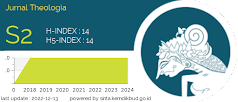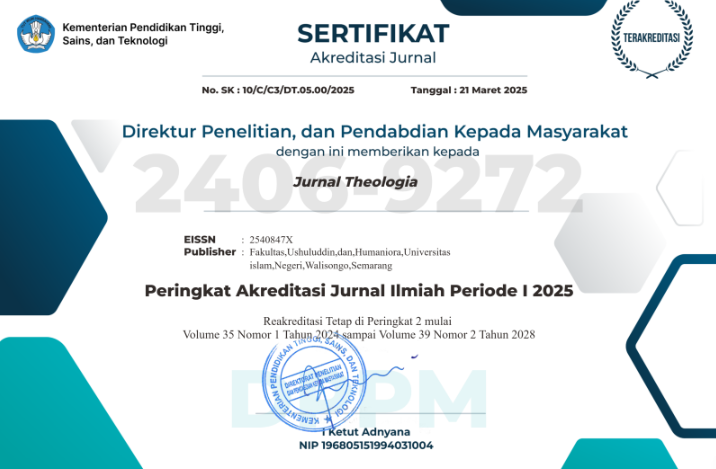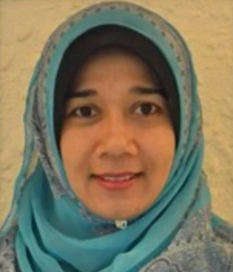PARADIGMA ANTROPOSENTRIS DALAM MEMAHAMI HADIS-HADIS MUAMALAH
DOI:
https://doi.org/10.21580/teo.2017.28.1.1295Keywords:
antroposentris, muamalah, paradigma, pemahaman hadisAbstract
Abstract: In this contents, Hadith reflects the different teaching of Islam, including creed, worship, and muamalah. All of that requires a different treatment and understanding the proportionally. This article examines how to understand the Hadiths in the field of muamalah and what is the paradigm construct of it. By using the method of subjective-humanistic hermeneutics, this article produces findings, as follows: first, the Hadiths of muamalah reflect construct of human relationships and it can change according to the changes and development of social life. Therefore, these Hadiths can be understood by using the anthropocentric paradigm, oriented on the needs of humans and make it as a subject and object either of the understanding. Second, this anthropocentric paradigm aims to find the sunnah and host it again in the present day. This anthropocentric understanding holds on to the principles and the universal values contained in the text of the Hadith as well as humanistic social ethics that upholds human values that are fairness, equal and tolerant without discrimination in various fields.
Abstrak: Dari segi kandungannya, hadis Nabi mencerminkan muatan ajaran tentang akidah, ibadah dan muamalah. Kesemuanya itu membutuhkan pensikapan yang berbeda dan pemahaman yang proporsional. Artikel ini mengkaji bagaimana memahami hadis-hadis Nabi dalam bidang muamalah serta bagaimana konstruksi paradigma yang dimaksud. Dengan menggunakan metode hermeneutika subjektif-humanistik, artikel ini menghasilkan temuan, sebagai berikut: Pertama, hadis muamalah merefleksikan konstruk relasi manusia, dan bisa berubah sesuai dengan perubahan dan perkembangan kehidupan sosial. Oleh karena itu hadis-hadis ini bisa dipahami dengan menggunakan paradigma antroposentris, yang berorientasi pada kebutuhan manusia dan menjadikannya sebagai subjek sekaligus objek dalam pemahaman. Kedua, paradigma antroposentris ini bertujuan untuk menemukan sunnah Nabi dan menghadirkannya kembali dalam konteks sekarang. Pemahaman antroposentris ini berpegang pada prinsip dan nilai-nilai universal yang terkandung dalam teks hadis serta etika sosial humanistik yang menjunjung tinggi nilai kemanusiaan yang berkeadilan, setara dan toleran tanpa diskriminasi dalam berbagai bidang.Downloads
References
Abdullah, M. Amin, Studi Agama: Normativitas dan Historisitas?. Yogyakarta: Pustaka Pelajar, 1996.
Abdurrahman, M, “Menelusuri Paradigma Ulama dalam Menentukan Kualitas Hadis”, dalam al-Jami’ah Journal of Islamic Studies, Vol. 41, No. 2, 2003/1424, 417.
Adlabī, Ṣalāh al-Dīn al-, Manhaj Naqd al-Matn ‘inda ‘Ulamā’ al-Ḥadīth al-Nabawī, Beirut: Dār al-Āfaq al-Jadīdah, 1983.
Abidin, Ahmad Zainal, Madzhab Objektif dan Subjektif dalam Hermeneutika al- Qur’an Kontemporer. Tulungagung: STAIN Tulungagung Press, 2008.
Ali, Hadis Versus Sains Memahami Hadis-Hadis Musykil, Yogyakarta: Teras, 2008.
Ali, Nizar, Memahami Hadis Nabi: Metode dan Pendekatan, Yogyakarta: CESaD YPI al-Rahmah, 2001.
Arfa, Faisar Ananda, Wanita dalam Konsep Islam Modernis, Jakarta: Pustaka Firdaus, 2004.
Bayumi, Abd al-Mu’thi Muhammad, al-Islām fī al-Qarn al-ḥādī wa al-‘Isyrīn Ru’yah ‘Aṣriyyah li al-Islām. Mesir: Nahdhah Misr, 2010.
Brown, Daniel W, Menyoal Relevansi Sunnah Dalam Islam Modern . Bandung: Mizan, 2000.
al-Bukhari, Ṣaḥīḥ al-Bukhāri. I, Singapore: Sulaiman Ma’i, t.th.
Damīniy, Musfir ‘Azm Allāh al . Maqāyis Naqd Mutūn al Sunnah. Riyād: t.p., 1984.
Esack, Farid, Qur’an, Liberation and Pluralism: An Islamic Perspective of Inter¬religious Solidarity against Oppresion. Oxford: Oneworld Publication, 1997.
Ghalib, Muhammad, Ahli Kitab: Makna dan Cakupannya, Jakarta: Paramadina, 1998.
Ghazali, Muhammad al-, Fiqh al-Sirah, terj. Abu Laila, dkk. Bandung: al-Ma’arif, 1985.
HAM, Musahadi, Evolusi Konsep Sunnah(Implikasinya pada Perkembangan Hukum Islam, Semarang: Aneka Ilmu bekerja sama dengan IAIN Walisongo Press, 2000.
Hanafi, Hassan, Dialog Agama dan Revolusi. Jakarta: Pustaka Firdaus, 1991.
Hanafi, “Apa Arti Kiri Islam”, dalam Kazuo Shimogaki, Kiri Islam antara Modernisme dan Postmodernisme Telaah Kritis Pemikiran Hassan Hanafi, (terj) M. Imam Aziz dan M. Jadul Maula. Yogyakarta: LKiS, 1994.
Hidayat, Komaruddin, Memahami Bahasa Agama, Sebuah Kajian Hermeneutika, Jakarta:Paramadina, 1996
Hitti, Philip K, History of the Arabs, London: The Macmillan Press, 1974.
Ilyas, Muhammad Azhar dan Hamim (ed.), Pengembangan Pemikiran Keislaman Muhammadiyah: Purifikasi dan Dinamisasi, Yogyakarta: Majlis Tarjih dan Pengembangan Pemikiran Islam PP Muhammadiyah dan LPPI UMY, 2000.
Isma’il, Syuhudi, Hadis Nabi Yang Tekstual dan Kontekstual: Telaah Ma’anil Hadis Tentang Ajaran Islam Yang Universal, Temporal dan Lokal, Jakarta: Bulan Bintang, 1994.
Jawābiy, Muḥammad Ṭāhir al , Juhūd al Muḥaddithīn fī Naqd Matn al ḥadīth an Nabāwiyasy Syarīf, t.t.p.: Muassasah Abdul Karīm bin Abdillāh, t.th.
Jawziyyah, Ibn Qayyim al-, Zād al-Ma’ād, III, t.t.p.: Dār Iḥya al-Turath al-‘Arabiy, t.th.
Mas’udi, Masdar F., Islam dan Hak-hak Reproduksi Perempuan, Bandung: Mizan, 1997.
Muslim, Ṣaḥīḥ Muslim I. t.tp: Dar al-Fikr, t.th.
Najwa, Nurun, “Rekonstruksi Pemahaman Hadis-hadis Perempuan.” Disertasi. Yogyakarta: UIN Sunan Kalijaga, 2006.
Najwah, Nurun, “Telaah Kritis Terhadap Hadis-hadis Misoginis”, Esensia: Jurnal Ilmu-Ilmu Ushuluddin, Vol. 4, No. 2, Juli 2003.
Nasution, Adnan Buyung, “Hak Asasi Manusia dalam Masyarakat Islam dan Barat” dalam Natsir Tamara dan Elza Peldi Taher (ed.), Agama dan Dialog antar Peradaban, Jakarta: Paramadina, 1996.
Noorhidayati, Salamah, Hadis-hadis Diskriminatif terhadap Umat Beragama Lain: Pemahaman Hadis dengan Pendekatan Sosio-Historis, Tulungagung: STAIN Tulungagung Press, 2010.
________, “Menalar Pandangan Hadis-hadis tentang Perempuan”, Disertasi, Program Pascasarjana UIN Sunan Kalijaga, Yogyakarta, 2013.
________, “Paradigma pemahaman Hadis: Dari Kesahihan Menuju Kesalihan Hadis” Laporan Penelitian Individual, IAIN Tulungagung 2015.
________, Ilmu Mukhtalif al-Hadis Kajian Metodologis dan Praktis. Yogyakarta: Lentera, 2016
Qarafi, Abu al-Abbas Ahmad ibn Idris al-, al-Furūq fī Anwā’ al-Furūq, juz I, kaidah ke-36, Beirut: Dar al- Kutub al- Ilmiyyah, 1998.
Rahman, Fazlur, Membuka Pintu Ijtihad, terj. Anas Mahyuddin, Bandung: Pustaka, 1995.
________, Methodology in History, Karachi: Central Institute of Islamic Research, 1965.
Rayyah, Mahmūd Abū, Aḍwā ‘a1ā as Sunnah al Muḥammadiyyah aw Difā’ al Ḥadīth, Mesir: Dār al Ma'ārif, [t.t.].
Rudliyana, Muhammad Dede, Perkembangan Pemikiran ulum al-Qur’an dari Klasik sampai Modern, Bandung: Pustaka Setia, 2003.
Sabiq, Sayid, Fiqh al-Sunnah , Beirut: dar al-Fikr, 1983.
Soemardi, Selo Soemardjan dan Soelaeman, Setangakai Bunga Sosiologi, Jakarta: Yayasan Badan Penerbit Fakultas Ekonomi Universitas Indonesia, 1964.
Suryadi, “Rekonstruksi Kritik Sanad dan Matan dalam Studi Hadis” dalam Esensia: Jurnal Ilmu-Ilmu Ushuluddin, Vol. 16, No. 2, Oktober 2015.
Suryadi, Hamim Ilyas & (ed.), Wacana Studi Hadis Kontemporer, Yogyakarya: Tiara Wacana Yogya, 2002
Syalṭut, Mahmud, al-Islām ‘Aqīdah wa Sharī’ah, Kairo: Dār al-Qalam, 1966.
________, al-Islām ‘Aqīdah wa Sharī’ah. Beirut: Dar al- Fikr,1996.
Umar, Nasarudin. Argumen Kesetaraan Gender Perspektif al-Qur’an, Jakarta: Paramadina, 2001.
Watt, W. Montgomery, Muhammad Prophet and Statesman, London: Oxford University Press, 1996.
Wehr, Hans, A Dictionary of Modern Written Arabic, J. Milton Cowan (ed), London: Weisbaden Otto Harrassowitz, 1971.





















